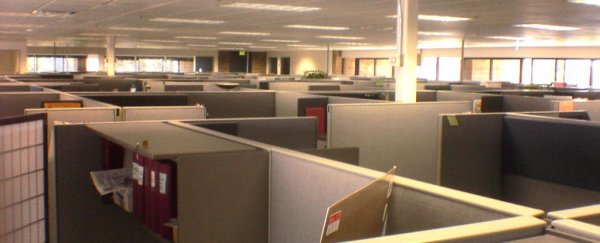Do you ever get that feeling at work where you can't think straight, or you feel drowsy and uninspired? Most people tend to blame their job for arousing this kind of fuzzy-headedness – and yep, that could be part of the problem! – but a new study reveals another likely culprit: the stale air in your poorly ventilated workspace.
Researchers led by Harvard University have found that people working in well-ventilated office spaces with below-average levels of indoor pollutants and carbon dioxide (CO2) demonstrate significantly higher cognitive functioning scores than workers in offices with typical levels of pollutants and CO2.
"We spend 90 percent of our time indoors and 90 percent of the cost of a building are the occupants, yet indoor environmental quality and its impact on health and productivity are often an afterthought," said Joseph Allen, assistant professor of exposure assessment science at the Harvard Centre for Health and the Global Environment. "These results suggest that even modest improvements to indoor environmental quality may have a profound impact on the decision-making performance of workers."
According to the researchers, ever since the 1980s office buildings have increasingly become more energy-efficient, but this trend has also meant they've become more airtight and insulated from the outdoor environment, increasing the risks of poor indoor air quality. New 'green' buildings are designed to be provide both energy efficiency and good indoor air quality, but are they really effective in marrying the two?
To find out, the researchers measured the performance of 24 professional participants – including architects, designers, programmers, engineers, and managers – in a controlled office environment for six work days, with the workspace specially ducted to perform indoor environmental air quality testing.
While they were engaged in their regular work, the participants were exposed to a range of varying indoor air qualities on different days. These included: normal office conditions with relatively high concentrations of volatile organic compounds (VOCs) being emitted from common materials; green conditions with low VOC concentrations; and green conditions with enhanced ventilation (called "green+").
They also exposed participants at times to artificially elevated levels of CO2 across all the air qualities. The workers were tested at the end of each day via cognitive performance tests.
The findings, published in Environmental Health Perspectives, show that green+ office conditions on average enabled workers to double their cognitive performance when compared with workers in conventional environments, while green conditions helped workers to score 61 percent higher.
The researchers tested nine different cognitive function areas in the tests, and the greatest gains were seen in strategy, information usage, and crisis response. In terms of the CO2 impact, the researchers found cognitive scores generally decreased as CO2 levels increased.
It's food for thought next time you get a chance to move desks in your office, with the research suggesting yet another reason why workers should try to nab that all-important window desk with a view. With modern climate-controlled offices, sadly, the chances of that window being manoeuvrable so you can grab some fresh air are pretty slim, but at least the exposure to light during daylight hours will do you some good.
In the meantime, the rest of us will have to wait for green or green+ style office buildings to slowly become the norm. Sigh! (At least we've now got something to point the finger at in the unfortunate event of a less-than-stellar performance review…)
